August 25, 2003 — The following provides details that some readers may not want to know before experiencing Mission: SPACE at Walt Disney World's Epcot themselves. To skip to the part of our review that includes only details advertised by Disney, click here.
It is the year 2036, 75 years after cosmonaut Yuri Gagarin paved the way for humanity into space, and the International Space Training Center now complements NASA by screening the thousands of hopeful candidates to help settle the new Mars base.
At least, that is the premise behind Mission: SPACE, the newest attraction to open at Walt Disney World Resorts' Epcot Center. Billed as the most extreme and technologically advanced ride Disney has ever attempted, Mission: SPACE is part flight simulator, part thrill ride, and part educational experience.
Approaching the Mission: SPACE pavilion, you first encounter the "Planetary Plaza," representing the Earth, the moon, Jupiter and an unnamed red planet (Disney considered over 100 shades of red before deciding on the one used). The Earth, moon, and Jupiter are only decoration, while the red planet (not to be confused with The Red Planet, Mars) serves as the entrance into the attraction.
For space history enthusiasts, the moon has been marked with the 29 sites where U.S. and Soviet manned and robotic missions landed between 1959 and 1976. Behind the moon, along the outside wall of the pavilion, inspirational quotes from the likes of Plato, Charles Lindbergh, President Kennedy and STS-107 crew member Kalpana Chawla are etched on glass plaques.
Following the wall of quotes leads you to the first hint of what awaits you inside. If you have ever ridden any of the theme park motion simulators, such as Body Wars, Star Tours, or Back To The Future, the mock ride craft on display in the entrance way may lead you to believe that Mission: SPACE falls into this category. You would be wrong.
However, you should already be well aware of this given the unsolicited advice of the flightsuit-clad Disney staff, who are all too eager to caution you as you approach the pavilion that Mission: SPACE is a very intense experience and may not be suitable for all.
Entering Mission: SPACE, once past the outside queue lines, you find yourself still waiting in line, but now in a room dominated by a slowly rotating gravity wheel reminiscent of the one seen in the 2000 film "Mission To Mars". Hanging from the ceiling is the scale model of the movie's spacecraft.
Not that either of these have anything to do with the ride you are about to board. Though certainly impressive, there is no mention of how these two fit into the imagined future for which you are about to embark, and you almost get the feeling that Disney decided to get some extra mileage out old props from a mediocre movie.
Instead, the spacecraft that you will fly, the X-2, is limited in this room to a schematic presented on a glass wall separating the "stand-by" trainees (a.k.a. those who have been waiting for an hour or more to ride) from those with a "Fast Pass" ticket, and as such goes largely unnoticed as the wheel is much more visually stunning.
Equally out of place, though more welcome, is the only real space artifact found throughout Mission: SPACE, a Lunar Rover built for the Apollo program on loan from the Smithsonian.
If there is a story to this room other than "cool space stuff" on display, it is difficult to decipher.
Thankfully, that all changes as you move down a narrow hallway, framed on the right by "Mission Control" and to the left a timeline of space "firsts", from Yuri Gagarin's 1961 orbit to the first family in space (complete with pet dog). (Note to Disney: Gemini 6 and 7 did not achieve the first docking, but rather rendezvous. The first docking was on Gemini 8).
The control room, presented behind a glass window, is staffed by real people (though it appears to be more for show than purpose) and offers your first glimpse at the ride itself. On overhead monitors, you watch a ten-armed centrifuge spin alternating with a view inside one of the pods at the end of each arm, where candidates, a.k.a. you in a few moments, hold on for dear life.
Moving forward, the queue is then divided into four color-coded bays with 40 people each, and then further organized into teams of four identified by the numbered circles on which you stand. The doors of this dispatch room close behind you and the lights dim, while overhead flat panel monitors flicker on.
Here you are introduced to your CapCom (who bares a very strong resemblance to "Mission To Mars" actor Gary Sinese). He explains that you are here to undergo flight training, the most extreme of all simulations an astronaut candidate like yourself can experience.
Sinese explains that you, and your three crewmates, will soon be assigned positions aboard the X-2 simulator and will fly a mission to Mars. The X-2 rocket can accelerate from 0 to 60,000 mph in 60 seconds explains Sinese, so when you hear "Go For Launch", you know you are in for the ride of your life. Claustrophobic and motion sickness prone candidates are encouraged to advance (a.k.a. exit) to Mission Control training.
Assuming you are still along for the ride, you and your three mates follow a staffer down a curved hall until you come upon another set of numbered circles on the floor, corresponding to your team's designation from the previous bay. Each of you take a place on a circle and Sinese re-appears on the screen in front of you.
This final briefing before boarding covers two critical topics for mission success. First, you will be assigned a position — Commander, Pilot, Engineer or Navigator — which will require you to execute different commands (a.k.a. press flashing buttons) throughout the flight.
Second — and listen to this one carefully — you are advised to keep your head pointed forward and held back against the headrest. This experience is on a real centrifuge, with periods of increased G-loads, and as a result, the fluids in your inner ear can go a bit haywire if you should move your head rapidly while the ride is in motion. Simply translated, if you do not want to lose your lunch in a hurry, sit still.
From there, a door in front of you opens and you follow a colored path to your X-2 cockpit. Taking your seat, you stow any personal effects you may have in a bin in front of you and then you pull a roller coaster-style shoulder harness down over your head.
The doors of the X-2 then close and the cockpit controls move forward until they are only a few inches in front of your face. All four stations have similar layouts, including a manual control stick (in case autopilot fails), buttons and switches, and a monitor that fills most of your field of vision with the view out the forward window. A smaller video panel in between each of the stations provides for a view of Mission Control.
Your planned mission profile includes a slingshot around the moon, after which you will enter "hyper-sleep" for the multi-month journey to the Red Planet. When you awake, your landing site and target will be the Martian North Pole.
As you are completely encased within a window-less pod, there is no visual indication when or if you are spinning. Instead, as you lay on your back during liftoff you find you are pinned to your seat, your appendages feeling as though they are twice as heavy than they were seconds earlier.
Astronauts will tell you this is what launching to space really feels like — sort of. Disney won't divulge the exact number of G's achieved other than to say "of less force and less duration than an actual shuttle launch, and lower intensity than a typical roller coaster."
Still, the effect is a powerful one, especially if you have never ridden another centrifuge. It is a difficult sensation to describe but its as if your body weight has doubled. The effect is mostly felt on your face, where any loose skin is pulled taught towards the back of your head.
Equally amazing is the sensation when you reach space after a few seconds (as compared to the 8 minutes it takes today's rockets, including the Space Shuttle), when you literally float out of your seat. The effect is brief, as only moments later the second stage fires and you are once again shoved back into your seat.
Like any good simulation, MIssion Control is bound to throw at you some problems to troubleshoot, and this mission is not without its fair share. That said, we're not going to tell you what they are — that would be cheating!
Your flight will take approximately 4 minutes from capsule door close to open. From there, you are directed to the Advanced Training Lab, a space-themed arcade.
In "Mission: SPACE Race", two teams of up to 30 each man Mission Control stations and the crew of an X-2 (though this time its through a simple video interface). The goal, as explained by two comedic Disney staff team leaders, is a race from Mars, around the moon and to the finish line: the International Space Station. Game play is simple but challenging, and requires teamwork to win.
Across from Race is "Expedition: Mars" a very slick video game that puts you in control of an astronaut on Mars. Using a jet pack, you have four minutes to navigate the obstacles of the Red Planet, including dust storms and ice, to locate and rescue four of your fellow explorers.
Also part of this area is "Space Base", a play area for young children, and a video e-mail kiosk, "Postcards from Space."
Finally, the Lab empties into the Cargo Bay, the Mission: SPACE gift shop. Here, newly anointed members of the ISTC corps can find a wide array of astronaut supplies, from apparel to space food.
In a minor sense, Mission: SPACE delivers today exactly what it was designed to portray for the future: an astronaut candidate screening and training center. While surviving Mission: SPACE won't lead to NASA knocking on your door, it is a good test of how you would cope with some of the conditions encountered during space flight.
Though NASA has long done away with using centrifuge rides as part of their training regiment, potential space tourists who travel to Russia in hopes of qualifying for a flight to the International Space Station are subjected to increased G-loads using a centrifuge. While the forces experienced may be reduced and shortened on Mission: SPACE, the premise is the same.
The psychological forces may be even greater on Mission: SPACE. Disney hammers home the risk of getting sick so many times throughout Mission: SPACE, that it would be surprising if the warnings did not translate to a self-fulfilling prophesy. Not that Mission: SPACE is not extreme; it is and to say otherwise would be misleading. However, the warnings alone appear to be enough to introduce a pretty powerful case of the butterflies or jitters, even if you aren't claustrophobic or prone to motion sickness.
If Mission: SPACE has a primary shortcoming though, it fails to convey why it is the training you receive is important. The theming of the queue lines versus the ride itself versus the post-show does not translate to the same sense of enrichment that is experienced through other Epcot pavilions. Each of Mission: SPACE's components as stand alone attractions are compelling to various degrees, but as an integrated experience, they come just short of sending riders home with a deeper understanding of not just how an astronaut trains, but why.
That said, Disney should be saluted for their choice to keep Mission: SPACE steeped in reality rather than fantasy. Make no mistake, there is a high quotient of science fiction compared with science fact, but thankfully there are no strange aliens, phasers or beaming down. Instead, Mission: SPACE relies on the real challenges of space flight to provide for excitement.
Disney integrates into Mission: SPACE how to work as a team, an important aspect of astronaut training. Each of the three major activities either integrate or stress teamwork, and two of them require it for mission success. Mission: SPACE also highlights the role of Mission Control, both as part of the team and as individuals just as crucial as the flight crew.
Visually Mission: SPACE is stunning, from its Planetary Plaza entrance to Cargo Bay gift shop exit. When called for, the simulation graphics are reasonably accurate, use real data collected by NASA, and capture the majesty and splendor associated with space exploration.
Physically, Mission: SPACE packs a wallop. Not just the central simulator mind you, but the entire experience. From start to finish, Mission: SPACE keeps your adrenalin levels high. As expected though, the climax is the X-2 simulator, and it is unlike any other theme park attraction.
For the general public, Mission: SPACE translates to a greater appreciation for space exploration; the next best thing until they undertake real space training themselves (and Mission: SPACE might very well inspire some to do so).
For the space enthusiast, Mission: SPACE delivers an experience that rewards your knowledge with a close attention to the details that only someone in the know would recognize. It offers an opportunity for you to put your expertise to good use, as you impress bystanders as you assume the role of an impromptu tour guide. At times, you will need a willing suspense of disbelief, but this isn't "Mickey Mouse" space training either (well, you know what we mean).
Disney uses an excerpt from a speech delivered by President Kennedy as the motto of the International Space Training Center. Its not only good for bumper stickers and embroidered shirts, but is also sound advice: Choose to go! |
|
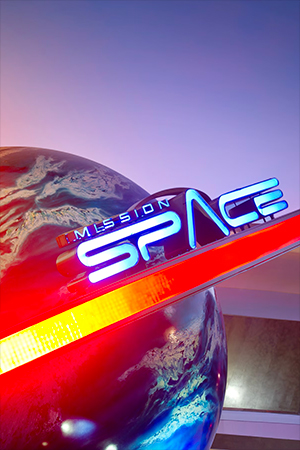
Mission: SPACE at Walt Disney World Resort's Epcot offers guests an authentic astronaut training experience. (Disney)
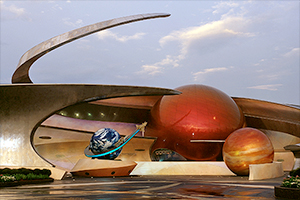
The entrance to Mission: SPACE is "Planetary Plaza," representing Earth, the moon, Jupiter and an unnamed red planet. (NASA)
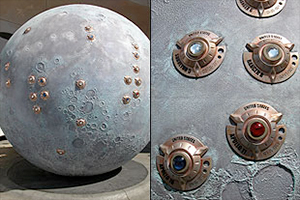
The moon in Mission: SPACE's Planetary Plaza has been marked with the 29 sites where U.S. and Soviet manned and robotic missions landed between 1959 and 1976. (Disney/collectSPACE)
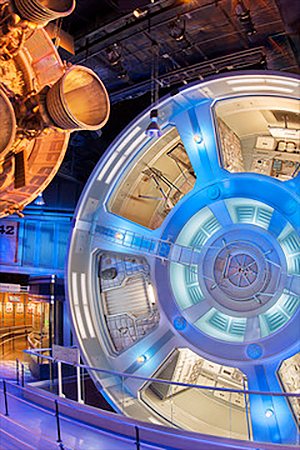
The Mission: SPACE queue includes the rotating gravity wheel from the film "Mission To Mars" and, suspended from the ceiling, a scale model of the movie's spacecraft. (Disney)
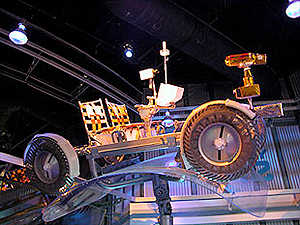
The only real space artifact found in Mission: SPACE, a Lunar Roving Vehicle (LRV) built for the Apollo program on loan from the Smithsonian's National Air and Space Museum. (collectSPACE)
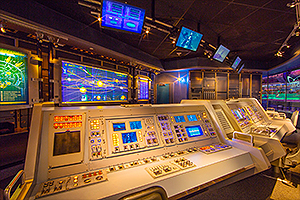
The Mission: Space control room, presented behind a glass window, is staffed by real people (though it appears to be more for show than purpose) and offers a first glimpse at the ride. (Disney)
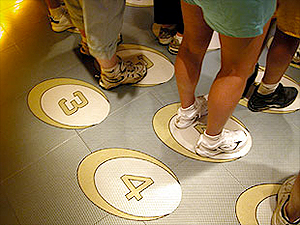
The Mission: SPACE queue is divided into four color-coded bays with 40 people each, and then further organized into teams of four identified by the numbered circles where you stand. (collectSPACE)
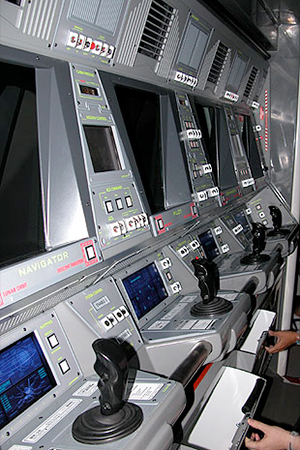
Taking your seat in the X-2 cockpit, you stow any personal effects you may have in a bin in front of you. (collectSPACE)
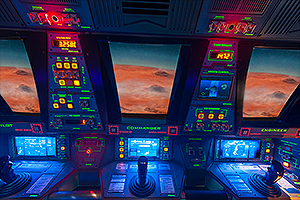
All four stations in the X-2 cockpit have similar layouts, including a manual control stick (in case autopilot fails), buttons and switches, and a monitor that fills most of your field of vision with the view out the forward window. (Disney)
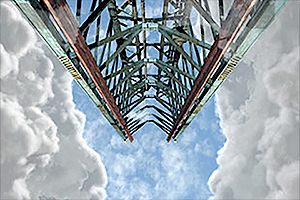
As you lay on your back during liftoff you are pinned to your seat, your appendages feeling as though they are twice as heavy than they were seconds earlier. (Disney) |
